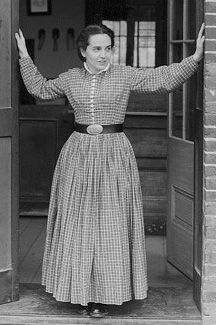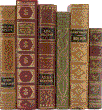
A WORK IN PROGRESS!
HOW SHOULD A WOMAN DRESS?

Andrea Edelman wearing a simple, yet nicely made, work dress
Image by Floyd D. P. Øydegaard

This page covers the styles most popular between
1875 to 1885.
Depending on your selected social standing and desire to do an
accurate portrayal, what you wear will have an effect on your period costume.
From the details of your
hair style to the very undergarments
you make: these will determine who you are and how much
historical interest you've placed in what you wear.
This page is only a guide and never the last word on the subject.
View old images and
"fashion plates" of the time you
wish to represent:
It's important you do your own research.
Remember that if your intention is to educate the public,
you do them a disservice when you don't make an accurate portrayal.
What you put on your face, such as
eyeglasses,
makeup,
earrings,
hats,
etc.,
is just as important as what you wear.
It's always best to start with a
naked form, covering it with a
chemise.
This garmet covers the skin to
protect it from the corset and usually falls atleast past your backside.
Sometimes it's below your knees; very much like a simple shift.
Over this goes the
corset.
By 1875 the corset
became longer then the earlier styles, and by 1882 suspenders
for stockings were attached.
(See 1886 style corset).
Drawers
(wrongly called bloomers or pantaloons)
were crotchless and reached the knee.
It may be wise to first put on
leggings (stockings)
and the bands (garters)
that hold them up above or just below the knee.
One would advise putting shoes on now, as it's mighty
difficult to tie shoes while wearing a corset.
After the corset has been
laced as tight as one is comfortable,
a
corset cover
(camisole or petticoat bodice)
was usually placed over this to protect
the corset and the dress.
Next came the
bustle pillow
or some sort of
wired bustle-shaped dress support (period names were:
tournure or dress improver) followed by multiple layers of
petticoats,
(crinoline or crinolette) and the
skirt which may be attached to the
jacket.
Another method popular in the 1880s was the
polonaise
which was a large part of the costume.
When you do your research, you will see that women of the night
dressed very much like a respectable lady if the money they
made allowed this. Read about the
infamous whores and what their short lives were really like.
Hollywood spent much of the mid 20th century creating
their image (like what the late 1890's theatre goer would have
seen on stage
of lace and feather clad
saloon girls,
dance hall girls, madames and women of loose morals.
These costumes were not what a woman wore in the streets.
In private she was most likely undressed to a single petticoat,
leggings, chemise (aka a shimmy) and corset.
She may have had a robe and let her hair down.
Somewhere between the petticoats and the finished coverage, a lady ought to
take the time to do her hair up in a
proper manner
that
suits the time zone and the socially accepted styles of that era.
Then find a
silly hat to cover it!

Places to learn more about women's clothing
-
Who Wore What? by Juanita Leisch.
ISBN 0-939631-81-4
-
Past Patterns
- The History of Underclothes by Willet & Cunnington
ISBN 0-486-27124-2
-
The Second Bustle Era (1880's)
- Where to buy period fabric, etc. for Gold Rush clothing; visit
Belinda Miller's Fancy Dry Goods & Clothing Store in Columbia, Ca.
or call her: 209-533-1849

 "GIT BACK!"
"GIT BACK!"

Write to: Black Bart the Legend at


Page created by

© 1984-to current year Shadows of the Past, Inc.
Want to see my Old West Reenactors Web Site? Touch
Shadows of the Past, Inc.

Click to see our Columbia Bookstore WebSite

Pages created by







 "GIT BACK!"
"GIT BACK!"






